
Design thinking – Process and Principles
Design thinking is a problem-solving process that’s used by designers and non-designers alike. It involves five steps: empathize, define, ideate, prototype, and test. The first step is to get inside the user’s head—literally!—and understand how they think and feel about their problems. Then you can create an empathy map that shows what users want from each aspect of their personal or professional lives.
Next comes defining the problem statement by identifying what’s wrong and coming up with ideas for how it could be fixed or improved. Then create mockups or prototypes of your thoughts so you can start testing them out in real-life situations with real people as early as possible in the design process.
What is Design Thinking?
A human-centered innovation strategy known as “design thinking” integrates the demands of people, the potential of technology, and the conditions necessary for successful company operations.
Before approving concepts that go to realization, designers investigate several ways, combine them into fresh ideas and prototypes, and test those with possible users.
Design thinking is a process that can be applied to a wide range of problems: working with organizations or individuals, solving intractable social issues or creating new products, coming up with strategies for competitive advantage, or managing day-to-day operations more effectively.
For example, You’re looking at ways to improve your company’s customer experience efforts—but you’re not quite sure which direction would work best. Try applying design thinking principles like empathy and user research instead of brainstorming possible solutions from scratch!
Or, Is your team struggling with how best to prepare itself for change by improving its communication and collaboration skills? Design thinking can help here too! Rather than just talking about it (or even just reading articles), try doing something different—like taking time out each week, so everyone attending gets their say while still allowing others who didn’t speak last time around an opportunity too…
History of design thinking
Design thinking is a human-centered approach to innovation. It combines the best of two worlds: the humanities, where we find empathy and creativity, and technology, from which it borrows rapid prototyping and testing.
Design thinking sees problems as opportunities. It’s a way of solving them through fast iteration, prototyping, and testing your ideas before deciding on one final solution. It encourages you to think about people when designing something new—how will it look? What will it feel like? How easy is it for people to use?
This approach isn’t just for large corporations or established brands—it works beautifully in small businesses too!
Types of Design Thinking
Design Thinking is a methodology for innovation that focuses on human-centered design. It is a humanistic approach to innovation that uses empathy and creativity to solve problems. Design Thinking can be applied in any industry to solve problems, create new opportunities, and improve lives.
Process of Design Thinking
- Identify the problem
- Discover the need
- Create solutions
- Test the solution
- Evaluate the solution
Principle 1 — Empathize with your users
Empathy is the ability to understand and share the feelings of another. It’s a fundamental part of human relationships, and it’s critical for design thinking. Empathy does not mean sympathy or feeling sorry for someone, but imagining what others might want or need in an attempt to see things from their perspective.
An excellent way to practice empathy is by observing people in their natural environments—the grocery store checkout line, at home making dinner with their kids on their lap—and asking questions like: “How do they feel?” “What are they trying to accomplish?” and “What would make this experience better?”
Principle 2 — Define a Meaningful and actionable problem statement
This principle is about defining and refining the problem you are trying to solve. It’s essential to determine a meaningful problem statement before you start solving it because otherwise, you may find yourself solving the wrong thing or spending time on tasks that don’t contribute toward your ultimate goal.
A solution statement includes:
- What we think is wrong (problem)
- How we plan on fixing it (action)
Principle 3 — Ideate by challenging assumptions and creating ideas for innovative solutions
In the design thinking process, you will challenge assumptions to look at your problem from different perspectives. You will try to uncover latent needs and develop new ideas for innovative solutions.
The goal is not merely to create a solution but also to generate several possible solutions that can be tested against each other to learn what works best. This is why we don’t talk about defining problems; instead, we insist on asking better questions to avoid getting trapped in what was already known or assumed.
Principle 4 — Prototype to start creating solutions
Prototyping is the process of creating and testing a model of your solution. It’s a way to test the design, make sure it works as intended, and get feedback from users. Prototyping helps you understand if your concept is usable and feasible before spending too much time building something that may not be usable or feasible.
Ideally, prototypes should be cheap to create — but they also have to be good enough so that people understand what you are trying to accomplish without confusing them or making them frustrated with the experience. A good prototype will show how something will work without needing lots of explanation; this makes it easy for everyone involved in the process (including potential users) to get on board quickly with an idea.
Designers use different methods for prototyping depending on their goals:
For example, some designers create paper prototypes that allow them to quickly try out different ideas and iterate through multiple versions over short periods.
Other designers might prefer digital prototypes using software such as Adobe XD or Sketch. In other cases, even simple sketches can suffice when working with stakeholders who don’t have technical expertise in UX processes as user research experts do.
Principle 5: Test those solutions in the real world.
Many designers and developers feel that when they have a prototype, it’s ready for presentation to users. However, there are many different ways to test your solution with real users.
For example, if you are creating a website or application that is meant for someone else (e.g., an internal system), then testing your design through interviews with end users can help you identify problems before it goes live. You could also test out prototypes on paper by doing sketches or wireframes of your ideas and showing them around before moving onto digital mediums such as websites or apps.
This will allow for feedback from others who may not necessarily be familiar with how things work behind the scenes on computers but do understand what would make sense in terms of functionality and usability once they see something tangible like a mockup rather than just words describing ideas.”
Conclusion
Design thinking is a potent tool for innovators and entrepreneurs. It allows them to think through problems from multiple angles and find creative solutions that might not have been possible otherwise.
It’s also a great way of approaching any problem you might face in life or business, whether designing products or services for customers who aren’t currently using them or figuring out how to get more people involved with your cause!






No Comments